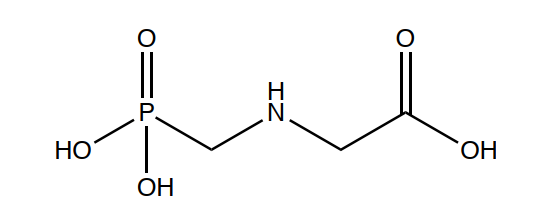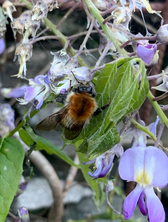Glyphosate – An effective but controversial weedkiller
Marketed under trade names including Roundup, glyphosate is a widely used herbicide. Recently, glyphosate usage has prompted a vigorous debate about its safety and toxicity.
Glyphosate, or N-(phosphonomethyl)glycine, is an organophosphorus compound analogue of the amino acid glycine. Under the tradename Roundup, glyphosate was sold worldwide, originally by the Monsanto Company, now part of the German multinational Bayer AG; many other weedkiller products now also contain glyphosate. Its chemical structure is as follows (1):
|
Nowadays, commercial manufacture of glyphosate follows either the “alkyl ester” route by reacting glycine with phosphorous acid and formaldehyde or the “iminodiacetic acid (IDA)” route, which replaces glycine with IDA (2).
Glyphosate is widely regarded as an effective weedkiller, which explains its long and widespread use. When applied, glyphosate enters the plant via the leaves. Once absorbed, glyphosate migrates to the growth parts of the plant. Then, by disrupting a synthase (enzyme), glyphosate stops the shikimate pathway, which regulates the synthesis of proteins, causing plant mortality. Glyphosate is commonly apply to soybeans, field corn, pasture, and hay production (3). Varieties of plants including soy and corn have been adapted to glyphosate, allowing selective action against non-crop weeds |
Animal and human exposure routes mainly include inhalation, ingestion, and dermal contact. Studies involving rats and mice exposed to high doses of glyphosate showed growth delays, kidney damage, liver enlargement and gastric disease (4). In 2015, the World Health Organisation (WHO) reclassified glyphosate as “probably carcinogenic to humans”. In a 2018 court case, Dewayne Johnson, a Californian groundsman who had developed non-Hodgkin’s Lymphoma, won damages from Monsanto of $226m, later reduced to $78m (5). Subsequent studies, however, have failed to provide conclusive evidence substantiating the WHO classification. Andreotti and colleagues (2018) studied glyphosate’s cancer incidence within a cohort of American pesticide applicators under the Agricultural Health Study (6). The cohort comprised 54,251 applicators of whom 44,932 used glyphosate. While 5,779 cancer cases were reported amongst glyphosate users, no correlation with glyphosate use was found. An increasing risk of developing acute myeloid leukaemia was reported amongst the highest use quartile. Nevertheless, no significant correlation was established.
Concerns have been heightened by studies reporting that glyphosate is almost ubiquitous in humans. According to the Heinrich Böll Foundation (7), traces of glyphosate were consistently detected in the urine samples across Germany (99.6% of the population); the highest concentrations were found in children and young people who had worked in the agricultural sector. In 2013, another German study comprising 182 samples of urine collected in 18 European countries showed that 45% of the samples contained glyphosate (8). While stakeholders received with alarm these results, the German
Federal Institute for Risk Assessment described them as “expected” and “less than one hundredth of the acceptable daily intake” (9); the Institute also criticised the scientific quality of the Heinrich Böll’s Study.
Concerns have been heightened by studies reporting that glyphosate is almost ubiquitous in humans. According to the Heinrich Böll Foundation (7), traces of glyphosate were consistently detected in the urine samples across Germany (99.6% of the population); the highest concentrations were found in children and young people who had worked in the agricultural sector. In 2013, another German study comprising 182 samples of urine collected in 18 European countries showed that 45% of the samples contained glyphosate (8). While stakeholders received with alarm these results, the German
Federal Institute for Risk Assessment described them as “expected” and “less than one hundredth of the acceptable daily intake” (9); the Institute also criticised the scientific quality of the Heinrich Böll’s Study.
|
In 2017, the European Chemical Agency’s Committee on Risk Assessment concluded that glyphosate should be classified as a substance causing serious eye damage and exerting toxicity on aquatic life with chronic effects. The available scientific evidence, however, did not meet the criteria to classify glyphosate for specific target organ toxicity, or as a carcinogenic, mutagenic, or reprotoxic substance. A following 2022 review concluded the 2017 classifications for glyphosate should be maintained. Again, no sufficient evidence was found to classify glyphosate as having other health or environmentally hazardous properties (10).
Safety data sheets consider glyphosate toxic to aquatic life, causing long-lasting effects, and recommend it must not be dispersed in the environment. Glyphosate shows toxicity to aquatic plants by disrupting photosynthesis, respiration, and amino acid synthesis (4). |
In soils, glyphosate is reported to break down, in a relatively quick reaction, into (aminomethyl)phosphonic acid(or AMPA). Degradation rates vary with temperature, soil type, and water availability. A strong chelating agent, glyphosate binds to minerals in the soil environment; this reduces its activity (11).
|
Because of intensive usage in agriculture, Van Bruggen and colleagues suggested a potential link between the proliferation of bacteria recalcitrant to glyphosate and the development of antimicrobial resistance in the environment (12). The authors speculated that both glyphosate and antibiotic resistance results from common mechanisms. Hence, changes in microbial populations driven by glyphosate exposure could translate into thriving antibiotic resistance strains with the potential harm to biota and humans.
A meta-analysis of 34 different studies linked an increase in bee mortality with exposure to glyphosate. When dosed at the manufacturer’s recommend concentrations, glyphosate seems to impact bee survival, development, and behaviour (13). Furthermore, researchers from the University of Texas at Austin (14) reported that glyphosate affects gut bacteria in honeybees, specially those strains using the shikimate pathway; altered gut microbiota can result in more bees prone to stressors (e.g. malnutrition and pathogens). |

The controversy surrounding glyphosate’s health and environmental impacts continues. The European Food Safety Authority is currently assessing the food safety implications of the European Chemicals Agency’s risk assessment decision (10). In the United States, the courts are starting to play an increasingly prominent role. In January 2020, the US Environmental Protection Agency (EPA) issued an interim decision claiming that, as long as revised mitigation measures were followed, glyphosate was safe to use from both a human health and an environmental perspective. The Agency also reiterated glyphosate’s non carcinogenic nature. Such
decision was challenged in a federal appeals court by a group o f food, agricul tural, and environmental stakeholders. The court noted EPA’s limited evaluation of the health and environmental risks associated with glyphosate, and ordered a thorough review of current evidence (15); citing insufficient time to address the court’s requirements, EPA withdrew its interim decision.
Disputes around glyphosate and the uncertainty about its toxicity are perhaps summed up by the wording that California’s Office of Environmental Health Hazard Assessment proposed for the labels of glyphosate containing products in the state: “CALIFORNIA PROPOSITION 65 WARNING: Using this product can expose you to glyphosate”. The International Agency for Research on Cancer classified glyphosate as probably carcinogenic to humans. US EPA has determined that glyphosate is not likely to be carcinogenic to humans; other authorities have made similar determinations. A wide variety of factors affect your potential risk, including the level and duration of exposure to the chemical. For more information, including ways to reduce your exposure, go to http://www.P65Warnings.ca.gov/glyphosate.
In summary, while being an effective weed killer, glyphosate is widely regarded as toxic in the environment. Evidence about its toxicity to humans remains a point of debate.
View expressed in this article are those of the author and do not represent those of the Environment Agency.
decision was challenged in a federal appeals court by a group o f food, agricul tural, and environmental stakeholders. The court noted EPA’s limited evaluation of the health and environmental risks associated with glyphosate, and ordered a thorough review of current evidence (15); citing insufficient time to address the court’s requirements, EPA withdrew its interim decision.
Disputes around glyphosate and the uncertainty about its toxicity are perhaps summed up by the wording that California’s Office of Environmental Health Hazard Assessment proposed for the labels of glyphosate containing products in the state: “CALIFORNIA PROPOSITION 65 WARNING: Using this product can expose you to glyphosate”. The International Agency for Research on Cancer classified glyphosate as probably carcinogenic to humans. US EPA has determined that glyphosate is not likely to be carcinogenic to humans; other authorities have made similar determinations. A wide variety of factors affect your potential risk, including the level and duration of exposure to the chemical. For more information, including ways to reduce your exposure, go to http://www.P65Warnings.ca.gov/glyphosate.
In summary, while being an effective weed killer, glyphosate is widely regarded as toxic in the environment. Evidence about its toxicity to humans remains a point of debate.
View expressed in this article are those of the author and do not represent those of the Environment Agency.
References
1. American Chemical Society. Molecule of the Week – Glyphosate, 5 October 2009. https://www.acs.org/ molecule-of-the-week/archive/g/glyphosate.html (Accessed 22.10.2022)
2. Dill, G.M., Sammons, R.D., Feng, P.C.C., Kohn F., Kretzmer, K., Mehrsheikh A., Bleeke, M , Honegger M.L., Farmer, D., Wright, D., and Haupfear, E.A. Ch 1. Glyphosate: Discovery, Development, Applications and Properties in Glyphosate Resistance in Crops and Weeds: History, Development, and Management. Ed. Nandula, V.K., 2010, John Wiley & Sons, Inc.
3. Covaci, A. Glyphosate: Environmental fate and Behaviour in Encyclopedia of Toxicology (Third Ed.), Ed. Wexler, P., 2014, Elsevier Inc.
4. Torretta, V., Katsoyiannis, I.A., Viotti, P., and Rada, E.C. (2018). Critical Review of the Effects of Glyphosate Exposure to the Environment and Humans through the Food Supply Chain. Sustainability, 10(4), 950. https://doi.org/10.3390/su10040950
5. BBC. Weedkiller cancer ruling: What do we know about glyphosate? 11 August 2018. www.bbc.co.uk/news/ world-us-canada-45155788 (Accessed 15.10. 2022)
6. Andreotti, G., Koutros, S., Hofmann, J.N., Sandler, D.P., Lynch, C.F., Lerro, C.C., De Roos, A.J., Parks, C.G., Alavanja M.C., Silverman, D.T., Beane Freeman, L.E. (2018). Glyphosate Use and Cancer Incidence in the Agricultural Health Study. Journal of the National Cancer Institute, 110(5), 509–516. https://doi.org/ 10.1093/jnci/djx233
7. Sagener, N. Almost all Germans contaminated with Glyphosate. The Ecologist, 08 March 2016. https://theecologist.org/2016/mar/08/almost-all-germans contaminated-glyphosate (Accessed 15.10.2022)
8. Hoppe, D-W. (2013). Determination of Glyphosate residues in human urine samples from 18 European countries. Medical Laboratory Bremen, D-28357 Bremen/Germany; unpublished test report MLHB-2013-06-06 of 12 June 2013. https://www.bund.net/fileadmin/user_upload_bund/publikationen/umweltgifte/glyphosat_urin_analyse.pdf (Accessed 15.10.2022)
9. German Federal Institute for Risk Assessment . Glyphosate in the urine: even for children, the detected values are within the expected range, without any adverse health effects, 04 March 2016. https://www.bfr.bund.de/en/press_information/2016/11/glyphosate_in_the_urine__even_for_children__the_detected_values_are_within_the_expected_range__without_any _adverse_health_effects-197173.html (Accessed 22.10.2022)
10. European Chemical Agency. Glyphosate: no change proposed to hazard classification, 30 May 2022. https://echa.europa.eu/-/glyphosate-no-change proposed-to-hazard-classification (Accessed 15 .10.2022)
11. The Soil Association. Impact of Glyphosate on soil health – The evidence to date, Report, 2016. https://www.soilassociation.org/media/7229/glyphosate-and soil-health-a-summary1docx.pdf
12. Van Bruggen, A.H.C., He, M.M., Shin K. Mai, V., Jeong, K.C., Finckh, M.R., Morris, J.G.Jr. (2018). Environmental and health effects of the herbicide glyphosate. Science of The Total Environment, 616–617, 255-268. https://doi.org/10.1016/j.scitotenv.2017.10.309
13. Battisti, L. Potrich, M., Sampaio A.R., de Castilhos Ghisic, N., Martins Costa-Maiad, F., Abati, R., Bueno dos Reis Martinez, C., Sofia, S.H. (2021). Is glyphosate toxic to bees? A meta-analytical review. Science of the Total Environment, 767, 145397. https://www.sciencedirect.com/science/article/pii/S0048969721004654
14. Motta, E.V.S., Raymann, K., Moran, N.A. (2018). Glyphosate perturbs the gut microbiota of honey bees. Proceedings National Academy Science USA, 115, 10305 – 10310. https://doi.org/10.1073/pnas.1803880115
15. Stempel, J. US EPA ordered to reassess glyphosate’s impact on health, environment. Reuters, 17 June 2022. https://www.reuters.com/business/environment/us agency-ordered-reassess-glyphosates-impact-health environment-2022-06-17/ (Accessed 22.10.2022).
1. American Chemical Society. Molecule of the Week – Glyphosate, 5 October 2009. https://www.acs.org/ molecule-of-the-week/archive/g/glyphosate.html (Accessed 22.10.2022)
2. Dill, G.M., Sammons, R.D., Feng, P.C.C., Kohn F., Kretzmer, K., Mehrsheikh A., Bleeke, M , Honegger M.L., Farmer, D., Wright, D., and Haupfear, E.A. Ch 1. Glyphosate: Discovery, Development, Applications and Properties in Glyphosate Resistance in Crops and Weeds: History, Development, and Management. Ed. Nandula, V.K., 2010, John Wiley & Sons, Inc.
3. Covaci, A. Glyphosate: Environmental fate and Behaviour in Encyclopedia of Toxicology (Third Ed.), Ed. Wexler, P., 2014, Elsevier Inc.
4. Torretta, V., Katsoyiannis, I.A., Viotti, P., and Rada, E.C. (2018). Critical Review of the Effects of Glyphosate Exposure to the Environment and Humans through the Food Supply Chain. Sustainability, 10(4), 950. https://doi.org/10.3390/su10040950
5. BBC. Weedkiller cancer ruling: What do we know about glyphosate? 11 August 2018. www.bbc.co.uk/news/ world-us-canada-45155788 (Accessed 15.10. 2022)
6. Andreotti, G., Koutros, S., Hofmann, J.N., Sandler, D.P., Lynch, C.F., Lerro, C.C., De Roos, A.J., Parks, C.G., Alavanja M.C., Silverman, D.T., Beane Freeman, L.E. (2018). Glyphosate Use and Cancer Incidence in the Agricultural Health Study. Journal of the National Cancer Institute, 110(5), 509–516. https://doi.org/ 10.1093/jnci/djx233
7. Sagener, N. Almost all Germans contaminated with Glyphosate. The Ecologist, 08 March 2016. https://theecologist.org/2016/mar/08/almost-all-germans contaminated-glyphosate (Accessed 15.10.2022)
8. Hoppe, D-W. (2013). Determination of Glyphosate residues in human urine samples from 18 European countries. Medical Laboratory Bremen, D-28357 Bremen/Germany; unpublished test report MLHB-2013-06-06 of 12 June 2013. https://www.bund.net/fileadmin/user_upload_bund/publikationen/umweltgifte/glyphosat_urin_analyse.pdf (Accessed 15.10.2022)
9. German Federal Institute for Risk Assessment . Glyphosate in the urine: even for children, the detected values are within the expected range, without any adverse health effects, 04 March 2016. https://www.bfr.bund.de/en/press_information/2016/11/glyphosate_in_the_urine__even_for_children__the_detected_values_are_within_the_expected_range__without_any _adverse_health_effects-197173.html (Accessed 22.10.2022)
10. European Chemical Agency. Glyphosate: no change proposed to hazard classification, 30 May 2022. https://echa.europa.eu/-/glyphosate-no-change proposed-to-hazard-classification (Accessed 15 .10.2022)
11. The Soil Association. Impact of Glyphosate on soil health – The evidence to date, Report, 2016. https://www.soilassociation.org/media/7229/glyphosate-and soil-health-a-summary1docx.pdf
12. Van Bruggen, A.H.C., He, M.M., Shin K. Mai, V., Jeong, K.C., Finckh, M.R., Morris, J.G.Jr. (2018). Environmental and health effects of the herbicide glyphosate. Science of The Total Environment, 616–617, 255-268. https://doi.org/10.1016/j.scitotenv.2017.10.309
13. Battisti, L. Potrich, M., Sampaio A.R., de Castilhos Ghisic, N., Martins Costa-Maiad, F., Abati, R., Bueno dos Reis Martinez, C., Sofia, S.H. (2021). Is glyphosate toxic to bees? A meta-analytical review. Science of the Total Environment, 767, 145397. https://www.sciencedirect.com/science/article/pii/S0048969721004654
14. Motta, E.V.S., Raymann, K., Moran, N.A. (2018). Glyphosate perturbs the gut microbiota of honey bees. Proceedings National Academy Science USA, 115, 10305 – 10310. https://doi.org/10.1073/pnas.1803880115
15. Stempel, J. US EPA ordered to reassess glyphosate’s impact on health, environment. Reuters, 17 June 2022. https://www.reuters.com/business/environment/us agency-ordered-reassess-glyphosates-impact-health environment-2022-06-17/ (Accessed 22.10.2022).





